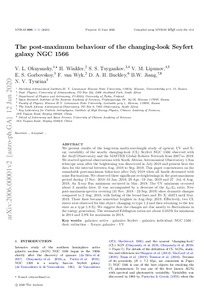The post-maximum behaviour of the changing-look Seyfert galaxy NGC 1566
Jiang BW; Tyurina NV; Oknyansky VL; Buckley DAH; Tsygankov SS; van Wyk F; Gorbovskoy ES; Lipunov VM; Winkler H
The post-maximum behaviour of the changing-look Seyfert galaxy NGC 1566
Jiang BW
Tyurina NV
Oknyansky VL
Buckley DAH
Tsygankov SS
van Wyk F
Gorbovskoy ES
Lipunov VM
Winkler H
OXFORD UNIV PRESS
Julkaisun pysyvä osoite on:
https://urn.fi/URN:NBN:fi-fe2021042822001
https://urn.fi/URN:NBN:fi-fe2021042822001
Tiivistelmä
We present results of the long-term multiwavelength study of optical, UV, and X-ray variability of the nearby changing-look (CL) Seyfert NGC 1566 observed with the Swift Observatory and the MASTER Global Robotic Network from 2007 to 2019. We started spectral observations with South African Astronomical Observatory 1.9-m telescope soon after the brightening was discovered in July 2018 and present here the data for the interval between 2018 August and 2019 September. This paper concentrates on the remarkable post-maximum behaviour after 2018 July when all bands decreased with some fluctuations. We observed three significant re-brightenings in the post-maximum period during 2018 November 17-2019 January 10, 2019 April 29-2019 June 19, and 2019 July 27-2019 August 6. An X-ray flux minimum occurred in 2019 March. The UV minimum occurred about 3 months later. It was accompanied by a decrease of the L-UV/LX-ray ratio. New post-maximum spectra covering (2018 November 31-2019 September 23) show dramatic changes compared to 2018 August 2, with fading of the broad lines and [Fe X] lambda 6374 until 2019 March. These lines became somewhat brighter in 2019 August-September. Effectively, two CL states were observed for this object: changing to type 1.2 and then returning to the low state as a type 1.8 Sy. We suggest that the changes are due mostly to fluctuations in the energy generation. The estimated Eddington ratios are about 0.055 per cent for minimum in 2014 and 2.8 per cent for maximum in 2018.
Kokoelmat
- Rinnakkaistallenteet [19207]
